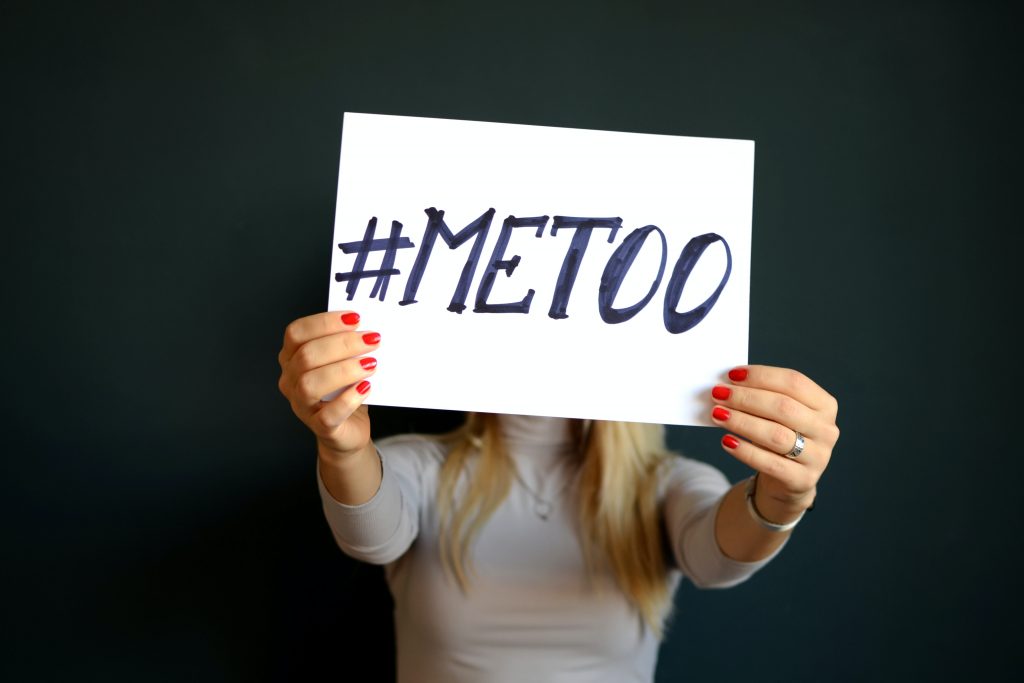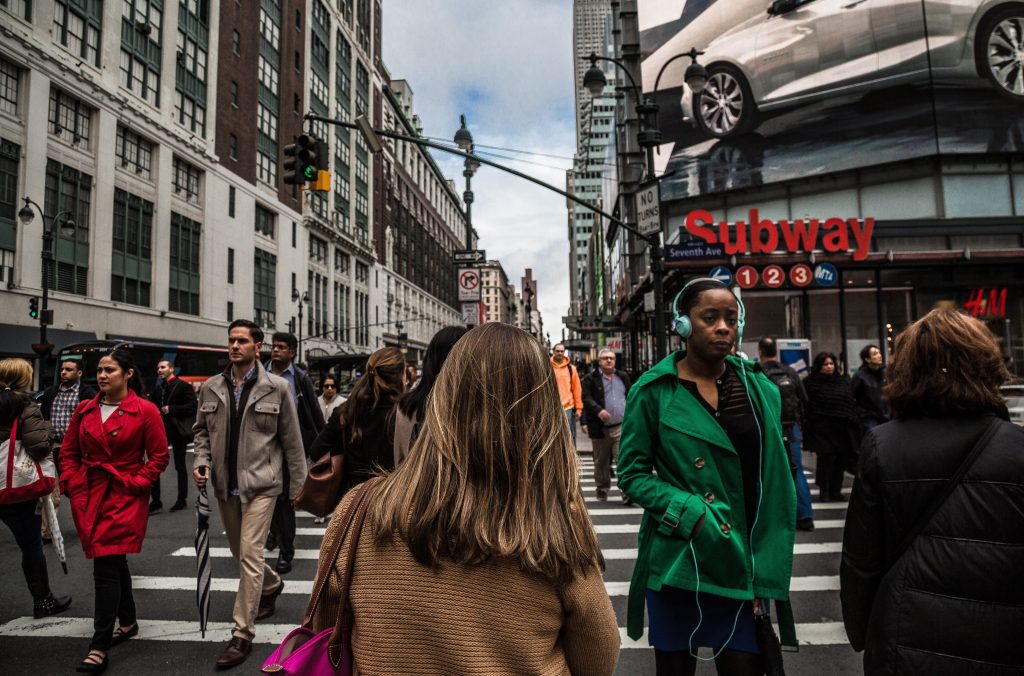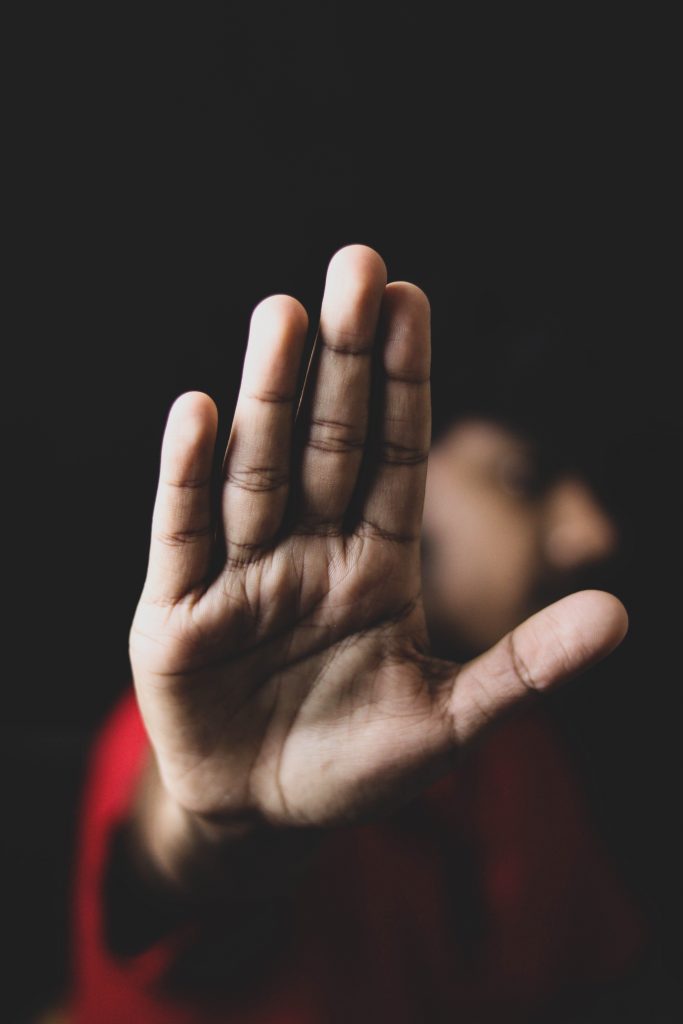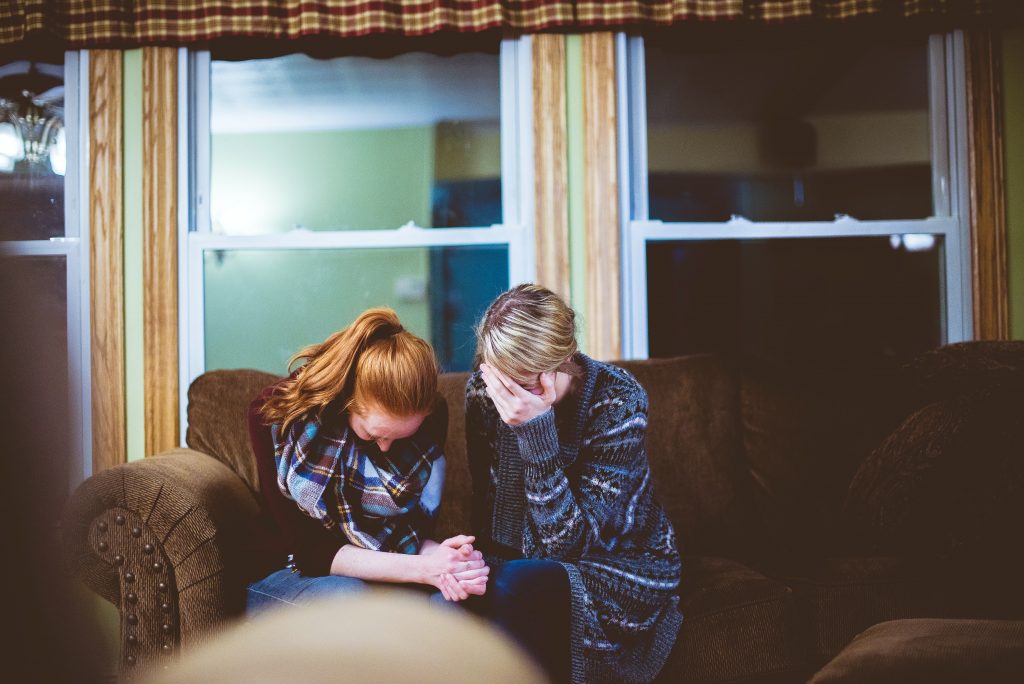An interview with Prof. Dr. Ella Roininen
Sven and Ella are in action again. This time Sven Lohmeier, Karls’ Storyteller and Bachelor graduate, formulated to Prof. Ella Roininen a range of questions on sexual harassment. Read the blog for insights and information on this extensive topic, and let us know your reflections, feedback and wishes for our future contributions.

1. Where does sexual harassment begin for you? How would you define sexual harassment?
I define sexual harassment as any unwelcome behaviour towards another person, which comes from a perceived position of power and privilege, based on the target’s intersectional gender position, and perceived by them as uncomfortable, offensive, humiliating or intimidating. This includes verbal and physical acts and gestures, as well as any images and virtual harassment.
Position of power and privilege in this context means that the harasser experiences their social ranking higher than their target’s. They may believe that men are above women, straight are above queer, white are above racialised groups, older people are above younger ones, and so forth. Even though the harasser may not consciously recognise or admit to this mechanism in their thinking, it is this socially constructed and internalised hierarchy between people that triggers and ‘justifies’ the uninvited behaviour.
So typically the perpetrator would believe: “I’m allowed to catcall you because I’m a man and you’re a woman.” If you mentally play this the other way around, you’ll see that it doesn’t really work, at least not without the woman standing out as unusual. Why? Because of the place and role men and women occupy in our cultural understanding.
Therefore, if a woman is to harass a man, this could happen more credibly from a position of being his supervisor or being his senior. When gay, queer and trans people are harassed by cis and straight-identifying people, heteronormativity is at play. Asian-looking women are at the intersections of gender and specific type of racialisation, which affects the type of harassment they get. Women not fitting into the dominant body norms tend to experience differently toned harassment than slim women. As you can see, there are different socially constructed ideas concerning different people, which can translate into harassment.
Work place harassment is another extremely harmful phenomenon. Characteristic to sexual harassment at the work place is organisational hierarchy, which puts the target in a precarious position in terms of their job or career.
Besides affecting the target individually, this restricts women and other marginalised groups’ participation in society’s institutions. In short, it perpetuates society’s unequal power relations and renders more decision making power to privileged and dominant groups in the institutions. Sexual harassment takes place in sport clubs, spaces for art and creativity, in political parties and their youth chapters, at educational institutions and workplaces—anywhere people meet and interact, build their capabilities, careers and lives. At best, it erodes the target’s sense of freedom and belonging, at worst shattering their mental health and sense of security. As a result, women step out, pull to the background, silence themselves, and move out to safer environments. This process is largely invisible to all involved.
Sexual harassment still tends to be conceptualised as an individual, rather than a structural and collective problem. How can you see the invisible and gradual disappearance of girls and women from talent pools? How can you act against the invisible? As long as the structures that allow harassment to continue are in place, we can only see the end result, and we may not trace it back to what happens at the grassroots level.
So when we talk about inclusion, we need to consider that institutions are not only biased, they can be violent, too. I encourage everyone to take a moment to think about the broad implications of this.

2. Are there different stages or forms of sexual harassment?
Sexual harassment can be conceptualised to operate on a continuum: What in some context demonstrates as teasing, asking personal questions, repeatedly asking for a date, or remarks about one’s appearance, can in another situation turn into suggestive signals, persistent texting, following the person, or blocking their path. And yet further on the scale are brushing up against, cornering, or forceful kissing, and even an actual or attempted sexual assault. The idea “I am entitled to you” is always a dangerous one, even when it shows up as relatively harmless actions.
I suppose sexual harassment could also escalate in frequency or in how many people take part in it, for instance at a work place, if the victim cannot voice their resistance or more people join the game, the same as school yard bullying. From my own experience, however, more usual is that different people independent of another perpetuate the culture of harassment.
One of the gravest problem is that sexual harassment keeps being conceptualised as a one-off, isolated incident. Instead of asking ‘Have you been sexually harassed?’, we should ask ‘Are you experiencing sexual harassement?’ It is the repetition of offensive, intimidating and humiliating looks, gestures and actions that are omnipresent in especially the lives of girls and women. It is the fear and expectation of them happening again and again.
We don’t talk enough about this. We as good as accept that girls grow into adulthood as free game. A recent research revealed that half of school age girls have experienced sexual harassment (Finnish Institute for Health and Welfare, 2020). It is a culture and structure into which both victims and harassers get socialised from a young age. So there may be one-off blatant cases of harassment and sexual violence, and then there is the escalating effect of being observed and commented to wherever one goes, so that one is never feeling completely safe and free to be themselves. So many people— friends, strangers, neighbours, cab drivers, teachers and professors, administrators and supervisors, even relatives—are part of this culture.

3. Which gender is most affected by sexual harassment, male or female and why is that?
Women are more commonly affected. Historically, in many societies, women’s lives have been restricted to private homes. Not so long ago, they couldn’t even work outside the home without a male relative’s or husband’s explicit permission, could not go to restaurants without a man, and could not study at a university. Sexual harassment in fact reflects women’s struggle to claim the right to be in those spaces as full and independent human beings. In a way the harasser is saying: “Go home where you belong to!” When you are in the company of a man, you will not get harassed, especially if the guy looks like a norm man. Sadly, this reflects the socially constructed gender hierarchy and the patriarchal idea of male entitlement to women’s bodies.
When I’m talking about men harassing women, it is not to blame or demonise men. This blog is not about men. It’s about the structures and experience of harassment, which is useful for everyone to learn more about. Also, in focusing your activism on seemingly one group, you risk marginalising others, generalising too much, or handling women as one uniform and clearly outlined category. Gender is a fluid concept and it intersects with many other social signifiers, as already demonstrated. Nevertheless, it’s also important to say: Now, this is the experience I am sharing about. I know I cannot do it right for everyone, but I want to talk about it. Why? Because from a young age, so many girls learn that their bodies are not just theirs, but are for other people to stare, comment, touch and violate. We are not doing enough to change this.
4. Is sexual harassment related to a society where sex is treated as a commodity?
Gender roles and gender norms are low hanging fruit for commercial actors to do business with. However, sexual harassment itself is not a new phenomenon; that we are talkingabout it is relatively new. The term has been around for only about 40 years and been popularised only in the past few years! When there is no concept to describe a phenomenon, it is not possible to act against it. In this way words, too, are power and silence enables violence. They reflect and perpetuate society’s power relations [1].
Commercial actors can effectively disseminate discourses in which these power relations are enforced, but can also help us to resist and challenge them. On the one hand, there’s the commercial content and movements that glamorise and normalise misogynist and racist behaviour. But as well there’s the more ‘innocent’ type of content and entertainment, which presents women as passive objects, and men as active go-getters. These reproduce certain ideas about men’s and women’s place and role in society, which people can model their lives after.
At the same time, commercial actors such as social media have proved to be highly empowering platforms for those wanting to learn more about and organise themselves against sexual harassment and gender based violence. Without the collective action, we’d be stuck with the individual experience!

5. What can a victim of sexual harassment do?
I highlight that the harm in sexual harassment lies seldom in just one isolated incident. It’s the frequent and repeated occurrence of smaller and bigger violations of one’s psychological and physical space, happening over years, which erodes your sense of freedom and security, and takes a lot of energy to deal with. All this is away from all the other things one can do in life. It also means that there is no effective way to escape sexual harassment, unless one has the ability to make themselves invisible!
It’s also possible that the target consents or participates in the situation, even though they experience it offensive. An example: A manager makes a sexist joke, and you end up chuckling with the others, even though you’re feeling uncomfortable. Sexual harassment comes masked in friendliness, humour and normal interaction, which easily sweeps one off track. We are brought up to be polite to others and maintain the communicative status quo. Therefore, challenging a situation turned awkward is more difficult than you’d think.
Moreover, as we know from the infamous Harvey Weinstein case, many of the affected women were complacent to the harassment and violence by being silent about it for a very long time, decades in fact. Why? The mechanism of harassment is not just tied to the dynamics between the individuals in question, but entangled into the entire cultural context in which it is taking place. Up until recently, and ever still, it’s widely accepted to disbelieve, silence and blame the victim, look the other way, and even support the perpetrator.
But to answer your precise question, considering an individual incident, such as remarks about one’s appearance, sexually suggestive gestures or inappropriate touching, there are several things one can do to reset the situation and minimise the damage to oneself.
Characteristic to incidents of sexual harassment, as earlier indicated, is that they tend to come out of nowhere. We have a valid reason to expect appropriate behaviour from our co-citizens, but harassers disregard this by behaving out of the script. They grab you when you least expect, shout obscenities out of a moving car, ask intrusive questions at a business meeting, or glue themselves to you on your way home from a club. This disregard to the normal, reasonable behaviour creates the perpetrator a unique space to keep going, because the target will be a) too stunned, b) too polite, c) too upset, or d) too scared to react. I call it the surprise effect, and it often leads to the target’s self-questioning and self-doubt: “Maybe I got it wrong?”, “Why didn’t I react?”, “Is it the way I dress?”…
Why be polite to a person who just insulted you? This has a lot to do with how women grow up: learning to be nice, used to having less voice, used to being called out if we use our voice. Sadly, we also get advised to “enjoy the compliment”—
All the more reason to learn how to react in a constructive manner! We can talk about different levels of reactions. Firstly, how to get the situation to stop and to get out of it. Secondly, how to get justice and stop the harassment in the long run.
This leads to what I call shifting the scrip, changing the game, which means learning different strategies to bring yourself up to the eye level with the perpetrator. You’ll have to challenge the situational power dynamics, show that you indeed are equal to them. Once you become aware that the situation is meant to make you feel small and insignificant, it’s much easier for you to react in an empowered manner.
Direct confrontation is not always possible or desired, for instance when one is dependent on their employer, or one is not confident enough to speak up and confront the harasser—which is not a character flaw but completely normal human behaviour. Speaking up is not necessary. There are other ways to signal that the behaviour is unacceptable and you are in charge. You can claim your space at least by four ways: your posture, gaze, use of voice and choice of words. How about blank staring a person cracking a sexist joke? Walking away with a disapproving look on your face, head high up. Even if you are boiling inside, joyfully wave to the moving car. Or execute an obscene gesture yourself.
I know this may sound absurd, but note that harassers expect you to be embarrassed and ashamed. This is part of the script, and for a script to function, all actors need to play their role. By taking charge you challenge the script. You tell yourself and the harasser: “I belong here”.So even if it is just for yourself, do not accept to feel a small, one-dimensional object, but your full size, wonderfully elaborate person.
Verbal tactics: Innocently asking for a clarification: “What do you mean by that? Why do you think that’s funny?” Or join the game and matronise: “You may have confused things, maybe I can help you?” Remember you don’t need to comply or feel flattered, even if they imply so. And there’s nothing to feel guilty about. Instead, be open and public about it. Ask loud enough for everyone to hear: “Why are you giving me the looks?” “I think your hand is in the wrong place”. It always helps to stay calm and detached. It’s not your bad behaviour. They know nothing about you, and you have all the right to your mental space and physical integrity.
But always, always, the most important thing is to get safely out of a potentially dangerous situation. Move away from the perpetrator as soon as you can. If the situation allows, ask them to stop, but don’t provoke anyone just to make your point. It’s not worth it, I promise you. Sometimes you may need to be assertive, sometimes it may be better to “fake befriend” the creep until you are safe, such as on empty streets at night.
To get justice and stop the harassment in the long run, every organisation needs to have an effective and confidential channel to report discrimination, harassment and abuse. Unfortunately, this is not always the case, plus the burden of proof tends to be on the victim’s side. How to gather courage to call out something that you cannot ‘prove’, especially when society’s institutions so often seem to punish the victim and side up with the perpetrator? I don’t have the answer to this. I can just advice you to protect yourself, your mental and physical health as far as you can, while you are working it out. Share your experiences with someone, ask for help and support.
By each of us’ persistence, work on different fronts, by setting personal example, we can change one thing at the time, and through this collective effort, things nudge forward to make the lives of those that come behind us easier.

6. What can a potential perpetrator do if they detect tendencies that they would not like to obtain/maintain?
Emma Pitman writes in her essay Misogyny is a Human Pyramid: “In Ways of Seeing, John Berger wrote that men look at women, and women watch themselves being looked at.” This means that both men and women control women’s behaviour and ways of being in the world. This comes down to the very long history of patriarchy in society. Part of the package is boys growing up into toxic masculinity, which codes emotions as weakness and shames boys for anything that could be considered feminine behaviour, including empathy.
So don’t despair if you have engaged in sexual harassment in the past, or if you are lacking tools to grow out of it. Lots of the behaviour that builds ground to sexual harassment is deeply ingrained in our culture, and goes unnoticed by us: Women gossiping about other women’s looks or dating habits, men joking about the new girl in the office. Following the #Metoo movement, there was a bit of a public outcry, some men saying it’s all too confusing, you no longer know how to act around women. I think it’s not difficult if one puts their head into it. If you are not acting on an autopilot, you will notice how harassment feels inside yourself. You have the capacity to be empathetic, and you can easily detect what is means to be polite and respectful to people.
I’ve heard some people confuse sexual harassment with flirting. It’s only natural that we want to be interesting and attractive to other people, and want to be approached in a positive sense. Flirting is respectful of one’s boundaries. It’s reciprocal and a source of pleasure and self-confidence. It gives you energy and lights up your day. Sexual harassment is the direct opposite of this.
So even if you have a huge crush on someone and seriously want to pursue them, or if you are out with your lads and want to impress them a bit, put yourself into the target’s shoes and read how they express themselves in words and body language. Anything that goes beyond the boundaries the person sets for themselves is harassment, and then we are dealing with ownership and self-entitlement.
You can also bite the bullet and talk about your behaviour. Normally people respect this. Ask whether you have been inappropriate and if so, apologise in a sincere manner. Be the model example of the smart, confident and egalitarian person that you are. People will know this, even if you’d blunder.
7. How can one protect themselves from harassment?
In principle, one could stop from being harassed by excluding themselves from society: not use any public transportation, stop going to the school or work place, skip the gym, supermarket, jogging, library, and holidays, and never again visit cafes, restaurants and nightclubs. But as you can guess, it’s not the responsibility of the target to protect themselves. Firstly, it is not their fault, and secondly, how do you stop something that is omnipresent?
We can stop harassment by talking about it openly and without the fear of being labelled boring, puritan, aggressive, or offensive. We can stop harassment by sharing our experiences without feelings of shame, and by showing our hurt and vulnerability. We can stop it by demanding society’s organisations and institutions to finally take sexual harassment seriously, and to make sure it’s handled as punishable behaviour.
We can also improve the architecture of our living environment: properly illuminate bus stops, passages and parking halls, install more security buttons in deserted places, offer real public transportation connections at all hours, move public restrooms to well populated spots, and so on. If this sound too much to ask for, I’d like to remind that most cities are built by people to whom sexual harassment and gender based violence do not exist, because they never experience it. If we are to be serious about safety, it needs to become normalised in city planning.
A Finnish author Anja Kauranen (1995) talks about the geography of fear, referring to women’s internalised knowledge on how to avoid sexualised crime in their living environment. Ask any girl or woman, and they would give you an arsenal of tactics to deal with harassment and the risk of being violated in their everyday life.
8. Women often hear the sentence “don’t dress to attractive or short when going out”, do you think this is a good prevention method or what do you think works best? (This is meant as picking up the stereotypes, I personally hate this argument)
I think my previous responses pre-empt this question. Plus, women in any outfit get harassed. Ask any woman anywhere in the world, wearing any dress style.

9. What to do if you detect somebody (in your friend’s group or publicly) who is being harassed?
Emma Pitman’s essay continues: “…I have often noticed a third party, an equally intimidating presence with a different gaze: men who watch other men as they watch, harass, or mistreat women. This occurs at every tier, and it can be both passive and active. It’s the bystander who averts his eyes as a stranger starts touching you on the train, or the guy who jeers across the bar as his mate harasses you. It’s the guys who will warn you about the ‘rapey guy’ in your social community, but still invite him to things.”
You’ll be complacent to harassment if you silently approve or actively excuse other men’s bad behaviour. If you trivialise the target’s experience, argue that nothing really happened, blame the victim for what happened or for calling it out, or get defensive and make it about you (“How do I flirt then?”, “Men get harassed too.”).
Even if you feel unsure or intimidated by the situation, perhaps sensing that familiar pressure from the school yard to be part of the crew, do not fall into being complacent. This closes, rather than opens doors for level solutions to harassment. Take an active role in stopping the harassment and supporting the target the best way you can. You don’t need to act rivalry, but of course you should interfere by helping them out of the situation, or distracting the perpetrators’ attention to yourself.

10. What can you do from a male’s perspective in order to comfort a woman/person that may have been a victim of sexual harassment?
Hear out what people want to share with you. Ask what you can do to support them. Take it seriously when women talk about their experiences, without trying to make it better for them or explaining it away. Believe them the first time—no need to question the victim’s experience, sense of humour, or their reality (“You’re being oversensitive”).
All we really want is it not to happen, so that we can carry on with whatever we were doing. Women are not as fragile as one may think, not even when their borders are being violated. Treat them as you would treat any friend in distress.
In case of an actual or suspected assault, make sure to accompany your friend to get medical and legal help. No one wants to end up alone at the ER or police station, to clarify a bunch of shocking events and intimate questions to strangers.
11. How to address a person that committed sexual harassment? What would you like to say to perpetrator if you could?
You can ask the harasser why they want to behave that way and how it made them feel. Ask innocent questions, and ask difficult questions, ask them to stop it, and ask them to respect people. Have conversations with your friends which move away from toxic masculinity towards caring and equal behaviour.
Mind you, if you confront a friend about their bad behaviour, it is not unusual them trying to make it look harmless. One should not tag along with this, but point out that their behaviour is simply bad and inexcusable, and explain why. I can imagine one may feel awkward or even shy to address such things, but the only way to break the silence is to break it. I’d try to deliver the perpetrator the message that their behaviour is sexist and outdated. I don’t think most people feel comfortable being labelled sexist and outdated, if they are made aware of it. If your friend behaves badly when he’s drunk, the best thing is to remove him from the situation and have a talk about it the next day. If the friend keeps defending his behaviour as acceptable, you may want to think about distancing yourself from them. For sure there are more sensitive and empathetic people around to hang out with, people who share your values.
12. Is sexual harassment more common in specific cultures?
The experience of sexual harassment is damaging anywhere in the world, but different places may have different rules for what women can do, and different expectations concerning men’s and women’s roles in society. Remember sexual harassment is about control. Control over where you move about, how you dress and with whom you are. This may cause sexual harassment to be more societally and politically accepted in some places than in others. Women suffer but may have less voice or power to challenge it, and the rest of the community may not want to challenge it. Protecting oneself agains harassment and violence may be purely upon individuals. This depends on historical and contemporary factors, such as legislation, societal hierarchies, the progress of women’s emancipation, their participation in society’s functions outside the home, and as said, generally on the rigidity of gender roles. Sexual harassment itself is not a cultural phenomenon. It is in societal structures, not in any region, ethnicity or anything else that can be fixed into the people themselves.

13. How can a trauma of harassment can be dealt with the best from the view of a psychologist?
It’s crucial for all parties to understand the mechanism of harassment, its omnipresence, and its effect on an individual. If someone shares their experience with me in a counselling session, I always make a point of hearing them out without questioning the experience, asking them what they need, and offering different ways to talk about their thoughts and emotions, which I hope to be stabilising and empowering to the individual. We think together ways to change the situation, if it’s ongoing, or ways to regain once bearings, if it’s a past event.
Even if a person seems to be vulnerable in the counselling situation, it doesn’t necessarily mean that they wouldn’t be strong and apt to handle their experience in the future, or that they are traumatised for good. By eye-level communication, sharing, showing understanding, nudging the person into a self-empowering direction in their thinking, trusting the person’s critical thinking abilities, and helping them to activate their self care and healing resources, we can get far. In case of dire experiences or a vulnerable mental health condition, I will encourage the person to contact a well trained psychotherapist, who will have a number of methods to handle traumas. Of course it is also important to check if the person needs legal and medical help, and support them in getting these.
14. Are there organisations or shelters to seek information or protection from harassment and sexual violence in Karlsruhe?
The city of Karlsruhe lists a number of contacts here: https://www.karlsruhe.de/bildung-soziales/schutz-praevention/schutz-vor-gewalt/schutz-vor-sexueller-gewalt.
For instance, the Wildwasser Karlsruhe offers support and help to all genders in questions and events of sexual violence: https://www.wildwasser-karlsruhe.de/
The national hotline for gender based violence, https://www.hilfetelefon.de/en.html, offers counselling 24/7 in several languages to victims and supporting persons.
If you experience any type of harassment, discrimination or abuse, at Karlshochschule or outside, or just want to talk about this topic, contact Ella Roininen via Teams, or at eroininen@karlshochschule.org
In this blog, we have expanded on sexual harassment, its different dimensions, and what to do about it. In the next blog, we’ll talk about intimacy and consent. Although addressing such topics ingrain discomfort, we shouldn’t be scared to make them visible. It is not within mine or your power to change the injustices of the world, but it is in our power to care about the experiences of those near us. We are not victimising anyone by talking about the problems. Victims are the individuals and systems who believe in discriminating stories about people, commit the crimes, or passively observe these happening, without attempting to fix the problem.
What a difference such a simple act as sharing and caring can do. It can lead to bigger effects than we can ever imagine.
[1] Miranda Fricker (2007) Epistemic Injustice:Power and the Ethics of Knowing. Clarendon Press.